Last week I showed you an 1880s Pingat in a mix of black fabrics relieved with ecru floral lace. Reactions too it were mixed, to say the very least. Some of you were extremely disappointed in Pingat (in all caps no less!), while others thought it was understated sophistication personified – hard to get more of a contrast than that! The thing that got the most agreement was that the beading on the skirt just wasn’t quite right – it either needed serious rearranging, or to go altogether.
I’ll be back in a few hours with a proper tally of the score for the Pingat gown, but for now internet problems are holding it up, so we’ll just move on to this week’s Rate the Dress:
There hasn’t been a lot of colour in my last few Rate the Dress selections, so I thought I’d best remedy that this week, and what could be more colourful than a dress completely in vermillion moire?
This dinner or reception dress in red moire features elaborate detailing throughout the bodice, with layers of what we would call ‘crumb catcher’ pleating to the bodice front, a variant of roleaux trimming down the centre front, and tiny dragons teeth dagging framing the neckline.
There is more detailing in the sleeves, with tightly pleated fabric held in place by banding in the upper arms, and releasing into full puffs just above the elbow.
The slim sleeves are held closed with buttons, and trimmed with more of the dragons teeth.
In contrast to the elaborate bodice, the full, pleated skirt is relatively simple.
What do you think? The 1830s can be a rather odd era stylistically, especially by modern standards, but as a dress of its era, how does this one rate? Is the vivid colour fun and refreshing in contrast to the many pale Romantic era frocks, or is it too bright and garish? Does this dress balance its silhouette and all the trimmings?
Rate the Dress on a Scale of 1 to 10

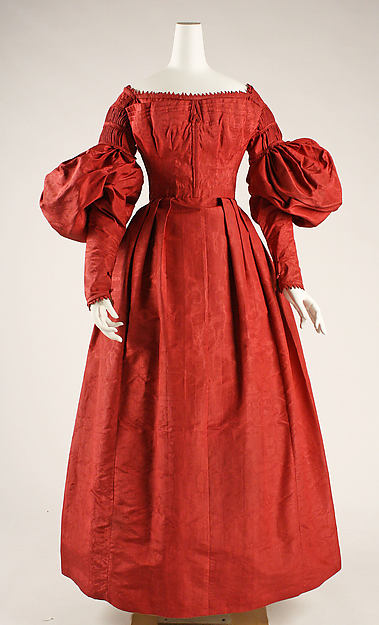
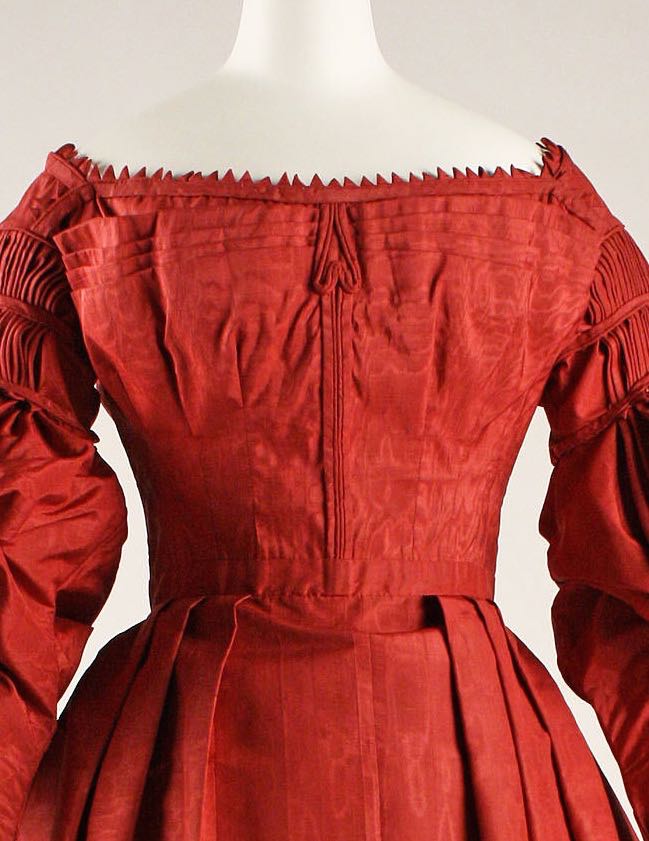
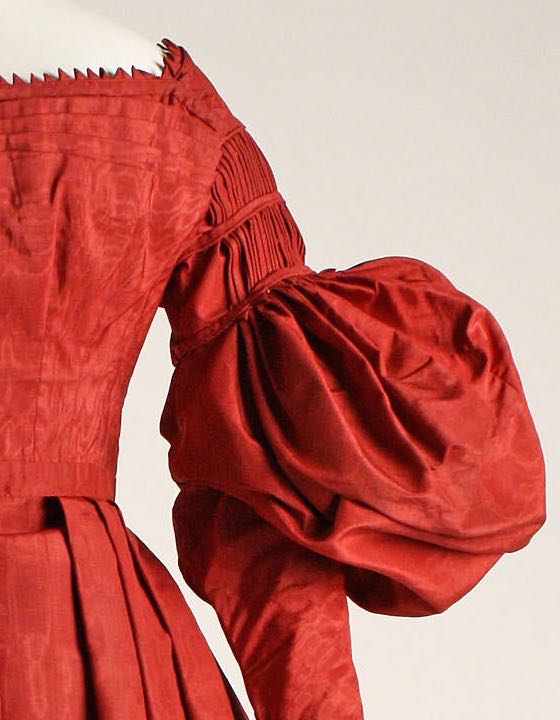
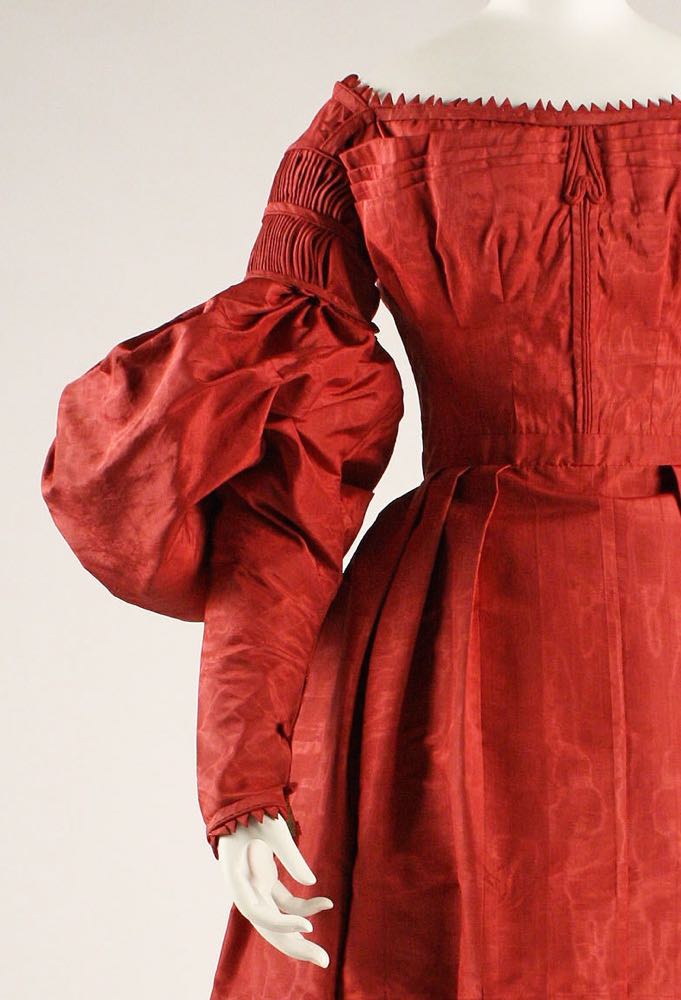
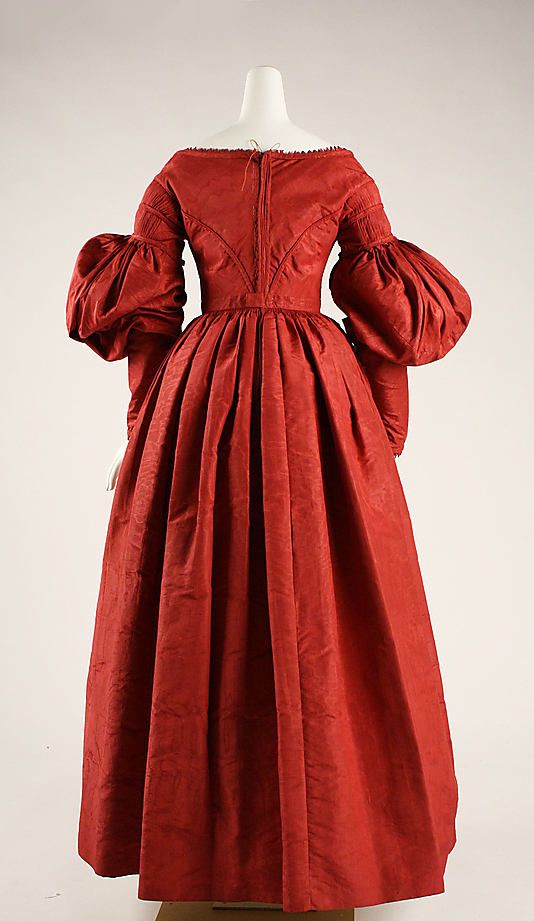
This is one of those instances where I have a hard time judging it fairly as an exemplar of its time, because I truly dislike those giant puffs of sleeves. I do recognize that they are a common feature, but all I can envision is being unable to maneuver through a room with a lot of bric-a-brac without knocking cherished items to the floor.
On the other hand, the fabric is lovely, and I can appreciate how moire shows off the features of the dress very well, and I find the color rich without being garish.
8 of 10
At first glance, it does nothing for me. From a distance, it looks lumpy and kind of stark, and the plain skirt feels unresolved. The waist seems to hang a bit oddly.
While this isn’t my favorite period, I’ve still seen 1830s gowns that I’ve loved way more than this one. On the other hand, maybe they weren’t as interesting. The color’s fun.
But those sleeve puffs. I think it’s the combination of size, them being the same color as everything else, and their being as low as they are. Plus I feel like they’d flop around like semi-deflated balloons when she walked. I know they used plumpers on those huge sleeves, but there would still be some odd looking arm movement. And honestly I don’t think adding the plumpers’ volume to these sleeves would make me like the silhouette more.
But I don’t like sounding this negative. The close-up shows some interesting elements, and I do like the toothy trim, crumb-catchers, and pleating on the sleeves. And the beautiful bell shape of the skirt. For me, that’s the appeal of the dress. Reduce the sleeve puffs and smooth out the waist some and I’d really like the dress.
I like the details, but my overall impression is still very negative, and I think that has to count for more.
6/10
I had a similar reaction to Cyranetta. Sort of love it, but the gigantic poofs … hm. They’re clearly a bit outlandish (and could prove challenging to those of us who tend to knock things over), but they also seem to make the dress perfectly “balanced.” Also, fabric, constructions, details, all lovely. I’d say
9 out of 10
Although the fashion of the 1830s is not exactly to my taste, I love this dress. The fabric is great, the colour just breathtaking! The details are great, I love the pleating, trimming and dragons teeth and the fact that the skirt is simple whereas the bodice is so elaborate. I think it would have been a real stunner. 🙂
10/10
Who was the woman who wore this dress in the 1830s I wonder. A 10 for the reasons stated above and as Tegan says: That is a perfect example of fabric manipulation.
10/10
That is a perfect example of fabric manipulation. 10/10 So beautiful. I wish I could think of things like that.
The style of the gown is a matter of taste. I am not a huge fan of the balloons at the elbows and the inverted heart at the neckline but it’s a fashion thing and I can respect that. What is kind of strange though that it looks sloppily made. Some of it might be the presentation and age but it has folds and creases where it shouldn’t.
But actually spending a second look at it especially on the close-up of the bodice, I just realized that it’s actually the creepiest dress I’ve seen on RTD. The zig-zags at the neckline look like shark’s teeth – like the dress just swallowed most its wearer and is about to get to the rest. The blood-red color obviously doesn’t help making any less creepy.
Of course, this dress being a flesh-eating garment that consumes its wearer makes it a 10, despite the sloppiness and the sleeves. The message and humor in that is just way too fantastic.
My first impression is that this gown is in an unusually bold color for a late 1830’s dress, For some reason I think of 1830s fashions as either pastel or drab in tone. The bright red color is refreshing, and surprising, in a good way. The workmanship on this gown is exquisite; tucks, pleats, self-trim. I like the tiny “dragon teeth” fabric bits along the neckline and sleeves–they provide confirmation that this gown is not to be worn by the timid.
The one issue I have with the gown is that the only ornamentation it has are tucks and pleats and self-fabric effects. From a distance greater than intimate conversational distance, this gown would appear absolutely plain. Although I don’t favor tons of ornament on clothing, I think that most gowns require something other than self-fabric trim. For this gown, I would recommend a black velvet belt with an ornate buckle of modest size, and some black velvet ribbon around the sleeves and neckline. But even as this gown stands today, I give it a 9.
I find it charming, and somehow the lower position of the sleeve puffs to the usual spot for this era pleases me eye. I cannot begin to imagine trying to eat in this dress though – what with the crumb and gravy and everything catcher, and trying to keep the puffs away from the plate, it is quite amusing. I am hoping it was a reception dress!
I adore the little dragon teeth edging. And all the little details, and I like how they are entirely rendered from the fabric. I do wonder who wore this – it is a very daring colour after all. This era is so very demure fashionwise, but the colour and the little teeth and the extra dropped shoulders read to me like a woman who wasn’t going to be simpering and hiding behind her fan. I give it 9/10. Not an era I am drawn to but I think it is a fab example of what could be done within the parameters of the fashions at the time.
First impression: safety orange kids’ swim arm bands.
Although I know tastes can and do change, I still dislike the first half of the 1800s: the sloped shoulders and low set sleeves for me convey a helpless, weak perception of women. I do like the huge sleeves of the 1890s, the original “power suit” style of wide shoulders, I don’t anticipate developing an appreciation for the 1830s styles any time soon, sorry. That definitely applies to this example. On the plus side, it is indeed a nice display of fabric manipulation… but only on the bodice. I know the plain skirt is rather typical of the 1830’s, but I would have liked to see that tooth trim again, about a foot above the hem. I like the colour, especially if the more vibrant photos are truer to its original hue. I wish the moire was more pronounced, but perhaps the photos do not do the fabric justice. The only thing I love is the toothed neckline edge. Looks like the dress is eating her.
3.5 for me.
Well….that is one way of making sure one isn’t crowded at the table and has
plenty of elbow room and ‘personal space’. With a shawl or cloak over the
dress, I could see those puffs giving a silhouette and having a practical purpose.
Striking tomato-red colour and the workmanship speaks of many hours and a
perfectionist. It’s like a dress an engineer would design!
I like it just the way it is.
8.5/10
I love it. It’s quite a warm, cheery colour, and the fact it’s a lot of detail and texture in one bold colour ia great. Sure, the sleeves are bonkers, but they also remind me of the Chinese lantern plant, same colour too, so it’s very pleasing because of that. Plus, the overall proportions are nice, and oddly, even though there’s WIDTH right at the waist because of the sleeves, it actually looks quite slimming, bizarrrely. 8/10. It needs accessories, but it’s a really great dress.
Just reminded me of the movie “Raise the Red Lantern”.
[WORDPRESS HASHCASH] The poster sent us ‘0 which is not a hashcash value.
Beautifully made but those puffs = oh dear. 6/10.
I love all of it. Everything. Big sleeves and the whole nine yards. The 1830s is one of my favourite clothing periods and vastly underrated in my humble opinion. Wonderful fabric sculpture and fantastic inventiveness. 10/10
I love all of it. Everything. Big sleeves and the whole nine yards. The 1830s is one of my favourite clothing periods and vastly underrated in my humble opinion. Wonderful fabric sculpture and fantastic inventiveness. 10/10
It’s hard to find anything to like in this dress. I do like the fabric although I don’t like the colour. Otherwise, the best I can say about it is that the little pleats on the upper arm are interesting. I’ve never liked puffed sleeves. I’d never seen them at the elbow before but I dislike them there more than anywhere else which is saying something! The pleats on the bodice are odd and I don’t like the heart decoration. I also find the dragon’s teeth really rather creepy! 2/10
As has already been said…the 30’s are at best odd. I love the teeth at the neck. Hate the crumb catcher pleats. What a pain to vacuum out! Pleats on the sleeve are awesome but the elbow puffs are just too much. I know, I know, that is what was in style then, but blah! The color is yummy! 5/10 It lost points because I can’t get past my modern sense of proportions.
9/10 For the simple reason that red is off putting for me. In another color or even shade it would be a 10. This is a unique era for dress styles, but I find the neck line and sloping shoulders very flattering, and there is no bustle! (yay) I also do like the poof sleeve, this does lend balance to the overall silhouette. As always with extant garments, my fingers start to hurt at the thought of all the tucks, gathers and tiny stitches….
I have no idea about the color being stylistically common for the period or not, but from a personal standpoint I like the color. The puffs on the sleeves are odd to me. I don’t particularly like leg of mutton sleeves to begin with, so this seems even stranger. (Although I will not dispute someone’s right to like the sleeves!) The fabric manipulation is a unique way to add interest, but I find the way they were placed a little odd to my modern viewpoint. To just go by techniques and not style, 7/10
I love it and especially enjoy the way the volumes, color and textures balance each other. 9.5/10
I adore this dress tbh. I’m weird and looove the 1830s, even though the clothes are kind of silly and a bit odd at times. I love the colour, though its not one I like to wear myself. The details are lovely. 10/10
I too object to the infantile way the dress of the 1830’s made women look. But this dress is something different. I believe only a mature woman could carry this off. The color is sensual, and while most dresses of the time restricted movement, this one does not. The fabric manipulation is imaginative, and I think her guests would be impressed by her understated (for the times) elegance. The elbow puffs seem to be a reluctant bow to the fashion of the day, while at the same time allowing full range of motion. This would be important if one were dancing, greeting guests, or climbing into a carriage. The beautiful carmine red is exciting, challenging, and lively. I would have liked this woman, hopefully as much as I like he dress. 10/10
It has teeth!! I have to be honest and say that when I look at the dress as a whole I am really not sure about the strange silhouette created by the sleeves. The puffs seem to be in a very odd position that doesn’t really complement the line of the dress. However, what I really love about this dress is the detail – the toothed edging, the pleats, the piping – everything about this dress draws your attention to the fine work and small details. Moreover, the choice of fabric is eye-catching to say the least but doesn’t in any way distract you from the beautiful seaming and embellishments. And I love the colour – who says they didn’t wear red in the 19th century?! I certainly wouldn’t turn down the chance to make or wear a dress like this one. Strange it may be, but intricate and interesting it certainly is. 8/10
If a lovely confident woman wore this dress to the Met costume show/party — she’d be in every photo collage. It is beautiful. Maybe diamond solitaire earrings.
For the dragons teeth and the colour alone this is an 8 to me. I don’t normally like the 1830s at all, but somehow putting the puffs further down the sleeves seems more flattering, and I like the way that the pleat details on the upper sleeves make them appear more connected to the rest of the dress.
I love colour, and the fact that all the trims are made from the dress fabric and, as a result, match it perfectly. I like those dramatic sleeves and the dragon’s teeth edging. The only thing I don’t really care for is that “crumb catcher” effect. So, I think that makes it a 9/10
I love this. Yes, the sleeve poufs are ridiculous, and the sharks teeth may be expressing a lot of poorly repressed anger. But imagine how much fun it would be to sweep around in this dress looking all demure while secretly plotting the bloody demise of your enemies. There’s just so much gusto. Also, how would you make this sharks teeth dagging? Is that a real thing? Where can I find a tutorial? I feel that my clothing may need to express some repressed anger too.
10 out of 10
30s dresses aren’t my favorite, but I think this is really fun and interestingly structured. I really don’t like the puffed sleeves of the era, but I love the way the pleating moving into those sleeves has been held down by bands and the detailing on the front.
My only question is: what is that bustline doing? Is it really gaping up there as much as it looks in the photos, and if so, is that a size difference between the under-bodic and over-bodice? Why that rather odd attachment at the top left? Is that it’s main fastener and it’s just not pulled tight enough to hide the drooping?
This dress comes out at a 7.5/10 for me. Great top, amazing detailing, but could have carried some of that through to the bottom of the dress.
Such a 10. I love the 1830s. The common dress of the Romantic era is the perfect amalgamation of simple and highly detailed. The vandyke points, rouleux, and precise pleating across the bodice are all excellent examples of the dressmaker’s art. Thank you for sharing <3
Really strikingly beautiful – lovely fabric, beautiful silhouette and lines…9/10 because,while looking wonderfully dramatic, the puffy bit at the sleeves ALSO manages to look as if the wearer had awful inflammantion of the joints and therefore badly swollen elbows.
I’m too late to bring the score up, but it would be a 10 from me. It’s the cover of my 1830s Pinterest board, and as 1830s go, it’s perfect!